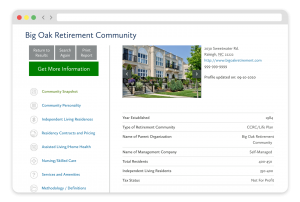So you’ve done your research, visited several locations, and have chosen the life plan community (aka continuing care retirement community or “CCRC”) that you feel is best for you. But there’s one minor issue you may still be faced with: paying the entry fee.
The vast majority of life plan communities require an entrance fee to help fund the breadth of services that will be available to you today, and also in the future as your healthcare needs change. Most people prefer to sell their home to fund the entry fee. If the home can be sold fairly quickly, then this is the most logical approach to be sure. Yet, depending on the location, real estate market, and condition of the home, this may not always be the case. The risk in waiting too long is that if your health should decline, there is a chance you will no longer be able to meet the entry qualifications for the CCRC.
Other entry fee funding options at a life plan community
So, if selling your home is not the simplest, fastest solution, here are three other methods that could potentially be utilized to help fund the entry fee, perhaps in combination:
Disclaimer: The following methods are not recommendations and should not be considered financial advice. Talk with your own financial and tax advisors before making any decisions.
Bridge loans: Some banks may offer a bridge loan to help cover the entry fee, which is paid back when your house sells. Check with the retirement community to see if they have a relationship with a bank or other financial group that can offer such loans. The retirement community may even pay the interest for you. It’s worth asking! Check out Second Act Financial* as an example.
Selling stock: This would not be advisable if you are using the stock to generate income or if you feel you will need to use it for income down the road. However, if you own stock that you do not plan to touch or have avoided selling due to capital gains, then it could make sense to sell some of the stock to help cover the entry fee. After your home sells, you can purchase new stocks in an equivalent amount, with a new cost basis, or you may decide to put the money in a different, and perhaps more conservative, type of account. There are a couple of things to take into consideration here:
- If the stock has no gain–which is not likely if you’ve owned it for a long time–then you do not need to be concerned with capital gains tax, and you can likely even take the losses again future gains. If there is a gain, then the capital gains tax due will depend on your tax bracket and whether you’ve owned it for more than a year. See the capital gains tax brackets here. If the stock was purchased over time, and at different amounts, you may be able to select which shares to sell. In this case, you could sell the ones with the smallest gains and leave the higher appreciated shares in place. (Important: Selling stock could effectively put you in a higher tax bracket thus generating a higher capital gains tax on the stock sale. Also, if you have owned the stock for less than one year the then it is considered a short-term gain, which would be taxed at ordinary income tax rates.)
- Many residents of a life plan community qualify to deduct a fairly significant portion of the entry fee, and monthly fees, as a prepaid medical expense. (A deduction equal to 20 to 40 percent of the entry fee and/or monthly fee is not uncommon.) If such a deduction is allowable, and you qualify for it personally, then this could help offset some or all of the capital gains tax due on the sale of stock. Be sure to ask a representative of the retirement community for documentation related a possible tax deduction on fees, and then discuss it with your tax advisor.
>> Related: Will My Refundable Entry Fee Be Taxed?
Reverse mortgage: This may be the last thing you would have considered as a way to fund the entry fee at a retirement community, and in many cases, it probably should be. However, under certain circumstances, it could make sense.
A reverse mortgage is essentially a form of home equity loan. The difference is that, unlike a traditional equity line of credit, there are no payments due while you are living in the home. The principal and interest aren’t due until after you, or your heirs, sell the home. Generally speaking, the older you are and the more equity you have in your home, the more money you can get from a reverse mortgage.
In terms of using a reverse mortgage to help pay the entry fee at a retirement community, there is a catch. Once you permanently move out of the home, the lender allows 12 months for you to sell the home and repay the loan. In the case of co-borrowers, the clock doesn’t start ticking until the second of the two borrowers moves out of the home permanently. Therefore, this method makes the most sense if you feel pretty sure your home will sell within a year, but you just don’t want to rush the process of moving or risk having a change in health while you wait for your home to sale, thus disqualifying yourself from meeting the CCRC’s health qualifications.
You can buy yourself extra time by remaining in your own home for longer, while going ahead and moving some of your things to the retirement community. Of course, you would be required to begin paying the monthly service fee at the retirement community, but you would also be able to use all of the amenities and services at the retirement community, just as you would if you lived there. As far as the CCRC is concerned, you would be a full-time resident. You could even stay there from time to time so long as it doesn’t jeopardize your status as a permanent resident of your primary home.
Making the right life plan community choice
There are a lot of factors to consider when it comes to choosing a life plan community or other retirement community, and one of the largest choices is how you’ll pay for it. That’s why it is so important to talk with your financial advisor and your accountant to determine which option for funding your entry fee will best meet your needs financially, both in the short and long term.
*This is not a solicitation or recommendation. The link is provided only for information purposes only and an example of potential resources available.

FREE Detailed Profile Reports on CCRCs/Life Plan Communities
Search Communities






